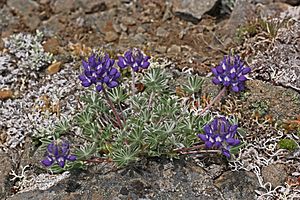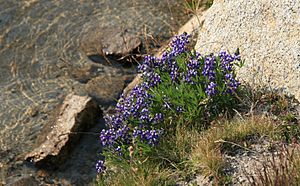Pacific lupine facts for kids
Quick facts for kids Pacific lupine |
|
|---|---|
 |
|
| Lupinus lepidus var. lobbii (prairie lupine) | |
| Scientific classification | |
| Genus: |
Lupinus
|
| Species: |
lepidus
|
The Lupinus lepidus, also known as the Pacific lupine, prairie lupine, or dwarf lupine, is a special kind of plant. It's a perennial herbaceous plant, which means it lives for many years and has soft, green stems instead of woody ones. This plant belongs to the pea family, called Fabaceae. It is found only in western North America, meaning it grows naturally nowhere else in the world.
Where the Pacific Lupine Grows
You can find the Pacific lupine in many open places across western North America. It grows in low prairies, open mountain forests, and even high up in alpine areas.
This plant is rare in British Columbia, Canada. However, its range stretches south from Alaska all the way to southern California. It also grows eastward into the Rocky Mountains.
In California, the Pacific lupine mostly lives in meadows. It likes areas that stay moist during the spring growing season. You can find it in the Sierra Nevada mountain range, at elevations from about 4,900 to 9,800 feet (1,500 to 3,000 meters) high.
What the Pacific Lupine Looks Like
The Lupinus lepidus is a small plant that feels a bit hairy. It usually grows to be about 4 to 24 inches (10 to 60 centimeters) tall. Its leaves grow all along the stem, but most of them are found near the bottom of the plant.
The leaves are shaped like a hand with fingers spread out. This is called "palmately compound." Each leaf has 5 to 8 small, green-gray leaflets. These leaflets are usually less than 1.5 inches (3.8 centimeters) long.
The flowers grow in a dense, spikelike cluster called a raceme. They can be pink, purple, or blue, and often have a yellowish spot. This beautiful plant blooms from the middle of April all the way through August. After the flowers, the plant produces a fruit that looks like a small pod, up to 0.75 inches (1.9 centimeters) long.


